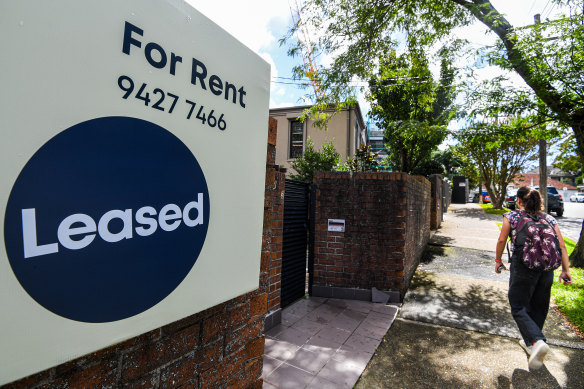By Rachel Eddie
The number of homes occupied by renters in Victoria has fallen by 10,400 in just three months and 15,600 in a year.
Government agency Homes Victoria’s most recent rental report, from the March quarter, which also reveals that the number of new lettings has plummeted 11.8 per cent in a year, highlights the worsening affordability in the state and the squeeze on renters.
The Homes Victoria data shows the number of active rental bonds declined to 658,106 in the March quarter, a figure 2.3 per cent below the same time a year earlier.
When people lease a home in Victoria, their bond is lodged with the Residential Tenancies Bond Authority, offering a measure of how many properties are rented.
The decline in rental bonds represents a drop of more than 15,600 rented homes in the year, or 10,400 in three months, and is well below the 10-year average annual change of increases of 3.1 per cent.
The Towong local government area, in north-east Victoria, had 9.5 per cent fewer bonds than it did a year earlier, and Gannawarra Shire, in the state’s north, had 7.3 per cent fewer. In Melbourne, the Port Phillip Council area had 4.8 per cent fewer, and Stonnington and Nillumbik municipalities were both down 4.7 per cent.
Tenants Victoria chief executive Jennifer Beveridge said more safe, secure and affordable rentals were needed.
“This data further confirms the pressure Victorian renters are facing in a very tough rental market that shows no signs of easing,” Beveridge said.

Tenants Victoria chief executive Jennifer Beveridge.Credit: Jason South
The rental bond fall has coincided with a shortage of new homes being built, because of labour and supply constraints, despite state government plans to add 800,000 homes in a decade.
The fall also coincides with an increase in land taxes paid by landlords and follows 13 interest rate rises since 2022, which the state government argues dwarfs the impact of state land taxes.
Australian Bureau of Statistics figures released last week revealed only 30.6 per cent of all housing loans in Victoria were taken out by investors amid an exodus of investors from the property market.
But a national high of 24.9 per cent of housing loans were to first home buyer owner-occupiers as Melbourne’s property market softens.
The state opposition’s spokesman for home ownership and housing affordability, Evan Mulholland, said Victoria’s taxes were tightening the rental market.
“Labor’s financial mismanagement has created a housing affordability crisis in Victoria which will only worsen as critical investment in new supply is driven interstate,” Mulholland said.

The March quarter figures represent the first annual drop in the number of active bonds since records began in 1999.Credit: Peter Rae
“Vulnerable Victorians can’t get a roof over their head because of the incompetence and mismanagement of the Allan Labor government.”
A government spokesman acknowledged challenges in the construction sector were holding back the number of homes being built, and pointed to ABS data that showed Victoria was still approving more residential construction than any other state.
“But more needs to be done and that’s why we’ll keep pulling every lever to enable 800,000 new homes to built over the next decade,” the spokesman said.
Real Estate Institute of Victoria president Jacob Caine said the state remained an attractive place to invest but all households were facing increasing financial pressure. He said it was important that average property investors were supported to keep supplying rental properties long-term.
“This data, along with other indicators, restates the urgent need to keep as many properties as we can in the rental housing ecosystem,” Caine said.
The Age previously reported that the number of bonds in Victoria declined year-on-year, by 0.8 per cent, for the first time in the December quarter. But the figure was later revised up by Homes Victoria, to a 0.1 per cent increase, meaning the March quarter now represents the first annual drop in the number of active bonds since records began in 1999.
The March quarter could also be revised upwards because of bonds lodged late, but that would not make up for a 2.3 per cent drop.
A total of 52,514 new rental bonds were lodged in the March quarter, a figure 11.8 per cent lower than in the March 2023 quarter.
The proportion of new lettings that Homes Victoria counted as affordable decreased statewide to 11.7 per cent, down from 15 per cent in the December quarter. Just 6.3 per cent of new lettings in Melbourne were considered affordable.
But the vacancy rate, according to Homes Victoria, remained stable at 2.1 per cent in Melbourne and 2.2 per cent for regional Victoria.
Real estate website Domain put the Melbourne vacancy rate at 0.8 per cent in February and found rents had increased 14 per cent in the year.
Start the day with a summary of the day’s most important and interesting stories, analysis and insights. Sign up for our Morning Edition newsletter.